Articles
- Page Path
- HOME > Korean J Community Nutr > Volume 18(6); 2013 > Article
-
Original Article
- Breast-feeding and Obesity in Early Childhood: Based on the KNHANES 2008 through 2011
- Miyong Yon, Haeng-Shin Lee, Dohee Kim, Jeeyeon Lee, Jiwoon Nam, Gui-Im Moon, Jinhwan Hong, Cho-il Kim
-
Korean Journal of Community Nutrition 2013;18(6):644-651.
DOI: https://doi.org/10.5720/kjcn.2013.18.6.644
Published online: December 31, 2013
Nutrition Management Service Team, Korea Health Industry Development Institute, Chungbuk, Korea.
1Food Safety Risk Assessment Division, Ministry of Food and Drug Safety, Chungbuk, Korea.
2Department of Anti-ageing Industry & Policy, Korea Health Industry Development Institute, Chungbuk, Korea.
- Corresponding author: Cho-il Kim, Department of Anti-ageing Industry & Policy, Korea Health Industry Development Institute, Osong Health Technology Administration Complex, 187 Osongseangmyeong2-ro, Osong-eup, Cheongwon-gun, Chungbuk 363-700, Korea. Tel: (043) 713-8611, Fax: (043) 713-8907, kimci@khidi.or.kr
Copyright © 2013 The Korean Society of Community Nutrition
This is an Open-Access article distributed under the terms of the Creative Commons Attribution Non-Commercial License (http://creativecommons.org/licenses/by-nc/3.0/) which permits unrestricted non-commercial use, distribution, and reproduction in any medium, provided the original work is properly cited.
- 1,229 Views
- 6 Download
- 11 Crossref
Abstract
- Although there has been a significant increase in breast-feeding (BF) rate in Korea, it is plateaued since 2008 and still low compared with that of other countries. Because BF has been related to lower obesity prevalence in many studies and the increase in childhood obesity became evident in Korea, we wondered if a relatively lower BF rate has anything to do with this increase. Therefore, we looked into the relationship between mode & duration of BF during infancy and weight status of toddlers using the data from Korea National Health and Nutrition Examination Survey 2008 through 2011. Number of 2-3 year old toddlers with complete information on BF, anthropometry and normal birth weight was 674. While 87% of them were ever-breastfed, 6.2% each of them were either obese or overweight based on the Standard Growth Chart for Korean Children. Not only the obesity prevalence was different among groups of different mode of feeding, but also the mean duration of BF was significantly longer in normal weight group (9.2 mo.) compared with obese group (5.5 mo.). Accordingly, overweight and obesity prevalence of the toddlers breast-fed for 12 months or longer was significantly lower than that of the toddlers breast-fed for less than 12 months (OR 0.53, 95% CI 0.32-0.87). This study revealed that both BF and duration of BF affect the childhood obesity and, BF for 12 months or longer should be encouraged more aggressively as one of the main strategies to prevent and/or decrease childhood obesity in Korea.
-
This research was supported by a grant (11162유해영732) from Ministry of Food and Drug Safety in 2013.
NOTES
- 1. Aguiar H, Silva AI. [Breastfeeding: the importance of intervening]. Acta Med Port 2011; 24: Suppl 4. 889-896.PubMed
- 2. Arenz S, Rockerl R, Koletzko B, von Kries R. Breast-feeding and childhood obesity-a systematic review. Int J Obes Relat Metab Disord 2004; 28: 1247-1256.ArticlePubMedPDF
- 3. Armstrong J, Reilly JJ. The Child Health Information Team. Breastfeeding and lowering the risk of childhood obesity. Lancet 2002; 359: 2003-2004.ArticlePubMed
- 4. Bahl R, Frost C, Kirkwood BR, Edmond K, Martines J, Bhandari N, Arthur P. Infant feeding patterns and risks of death and hospitalization in the first half of infancy: multicentre cohort study. Bull WHO 2005; 83(6): 418-425.PubMedPMC
- 5. Bergmann KE, Bergmann RL, Von Kries R, Böhm O, Richter R, Dudenhausen JW, Wahn U. Early determinants of childhood overweight and adiposity in a birth cohort study: role of breast-feeding. Int J Obes Relat Metab Disord 2003; 27(2): 162-172.ArticlePubMedPDF
- 6. Bogen DL, Hanusa BH, Whitaker RC. The effect of breast-feeding with and without formula use on the risk of obesity at 4 years of age. Obes Res 2004; 12(9): 1527-1535.ArticlePubMed
- 7. Cho KL. A study on the relationship between schoolage obesity and type of feeding in infant period. Pusan National University; 2005; 9-13 Dissertation.
- 8. Crume T, Ogden L, Mayer-Davis E, Hamman R, Norris J, Bischoff K, McDuffie R, Dabelea D. The impact of neonatal breastfeeding on growth trajectories of youth exposed and unexposed to diabetes in utero: The EPOCH study. Int J Obes (Lond) 2012; 36: 529-534.ArticlePubMedPMCPDF
- 9. Yensel CS, Preud'homme D, Curry DM. Childhood obesity and insulin-resistant syndrome. J Pediatr Nurs 2004; 19(4): 238-246.ArticlePubMed
- 10. Deckelbaum R, Williams C. Childhood obesity. Obes Res 2001; 9: Suppl 4. 239S-240S.PubMed
- 11. Dietz WH. The obesity epidemic in young children: Reduce television viewing and promote playing. BMJ 2001; 322: 313-314.PubMedPMC
- 12. Dietz WH. Breastfeeding may help prevent childhood overweight. JAMA 2001; 285: 2506-2507.ArticlePubMed
- 13. DiSantis KI, Hodges EA, Johnson SL, Fisher JO. The role of responsive feeding in overweight during infancy and toddlerhood: a systematic review. Int J Obes (Lond) 2011; 35: 480-492.ArticlePubMedPMCPDF
- 14. Ebbeling CB, Pawlak DB, Ludwig DS. Childhood obesity: public-health crisis, common sense cure. Lancet 2002; 360: 473-482.ArticlePubMed
- 15. Gillman MW, Rifas-Shiman SL, Camargo CA Jr, Berkey CS, Frazier AL, Rockett HR, Field AE, Colditz GA. Risk of overweight among adolescents who were breastfed as infants. JAMA 2001; 285(19): 2461-2467.ArticlePubMed
- 16. Harder T, Bergmann R, Kallischnigg G, Plagemann A. Duration of breastfeeding and risk of overweight: a meta-analysis. Am J Epidemiol 2005; 162(5): 397-403.ArticlePubMed
- 17. KCDC. 2007 Korean national growth charts. 2008; cited 2013 August 31]. Available from http://www.cdc.go.kr/.
- 18. KCDC/MOHW. Korea health statistics 2008: Korea national health and nutrition examination survey (KNHANES IV-2). 2009; cited 2013 August 31]. Available from http://knhanes.cdc.go.kr/.
- 19. KCDC/MOHW. Korea health statistics 2009: Korea national health and nutrition examination survey (KNHANES IV-3). 2010; cited 2013 August 31]. Available from http://knhanes.cdc.go.kr/.
- 20. KCDC/MOHW. Korea health statistics 2010: Korea national health and nutrition examination survey (KNHANES V-1). 2011; cited 2013 August 31]. Available from http://knhanes.cdc.go.kr/.
- 21. KCDC/MOHW. Korea health statistics 2011: Korea national health and nutrition examination survey (KNHANES V-2). 2012; cited 2013 August 31]. Available from http://knhanes.cdc.go.kr/.
- 22. Kim SH. The relationship between breast feeding and childhood obesity. Yonsei University; 2004; 22-23 Dissertation.
- 23. Krebs NF, Himes JH, Jacobson D, Nicklas TA, Guilday P, Styne D. Assessment of child and adolescent overweight and obesity. Pediatrics 2007; 120: Suppl 4. S193-S228.ArticlePubMedPDF
- 24. Lamb M, Dabelea D, Yin X, Ogden L, Klingensmith G, Rewers M, Norris J. Early-life predictors of higher body mass index in healthy children. Ann Nutr Metab 2010; 56: 16-22.ArticlePubMedPDF
- 25. Lim HJ, Park HR, Goo HK. A study on policy of obesity of children and adolescents. National Youth Policy Institute; 2009.
- 26. McCrory C, Layte R. Breastfeeding and risk of overweight and obesity at nine years of age. Soc Sci Med 2012; 75(2): 323-330.ArticlePubMed
- 27. Monterrosa EC, Frongillo EA, Vásquez-Garibay EM, Romero-Velarde E, Casey LM, Willows ND. Predominant breast-feeding from birth to six months is associated with fewer gastrointestinal infections and increased risk for iron deficiency among infants. J Nutr 2008; 138(8): 1499-1504.PubMed
- 28. Nader PR, O'Brien M, Houts R, Bradley R, Belsky J, Crosnoe R. Identifying risk for obesity in early childhood. Pediatrics 2006; 118(3): 594-601.ArticlePubMedPDF
- 29. Newburg DS, Woo JG, Morrow AL. Characteristics and potential functions of human milk adiponectin. J Pediatr 2010; 156: 2 Suppl. S41-S46.ArticlePubMedPMC
- 30. Oddy WH. Infant feeding and obesity risk in the child. Breastfeed Rev 2012; 20(2): 7-12.
- 31. OECD. OECD Family database. Breastfeeding rates. 2009; cited 2013 August 31]. Available from http://www.oecd.org/els/family/43136964.pdf.
- 32. Ogden CL, Carroll MD, Kit BK, Flegal KM. Prevalence of obesity and trends in body mass index among US children and adolescents, 1999-2010. JAMA 2012; 307(5): 483-490.ArticlePubMedPMC
- 33. Oh K, Jang MJ, Lee NY, Moon JS, Lee CG, Yoo MH, Kim YT. Prevalence and trends in obesity among Korean children and adolescents in 1997 and 2005. Korean J Pediatr 2008; 51(9): 950-955.Article
- 34. Oh SW. Diagnostic criteria for childhood obesity. Korean J Obes 2008; 17(4): 188-190.
- 35. Owen CG, Martin RM, Whincup PH, Smith GD, Cook DG. Does breastfeeding influence risk of type 2 diabetes in later life? A quantitative analysis of published evidence. Am J Clin Nutr 2006; 84(5): 1043-1054.ArticlePubMed
- 36. Owen CG, Martin RM, Whincup PH, Smith GD, Cook DG. Effect of infant feeding on the risk of obesity across the life course: quantitative review of published evidence. Pediatrics 2005; 115(5): 1367-1377.PubMed
- 37. Papoutsakis C, Priftis KN, Drakouli M, Prifti S, Konstantaki E. Childhood overweight/obesity and asthma: is there a link? A systematic review of recent epidemiologic evidence. J Acad Nutr Diet 2013; 113(1): 77-105.ArticlePubMed
- 38. Park JY. Association of predominant breastfeeding and obesity among Korean preschool children. Yonsei University; 2011; 29-33 Dissertation.
- 39. Prentice AM, Jebb SA. Beyond body mass index. Obes Rev 2001; 2(3): 141-147.ArticlePubMed
- 40. Savino F, Liguori SA. Update on breast milk hormones: leptin, ghrelin and adiponectin. Clin Nutr 2008; 27(1): 42-47.ArticlePubMed
- 41. Savino F, Petrucci E, Nanni G. Adiponectin: an intriguing hormone for paediatricians. Acta Paediatr 2008; 97(6): 701-705.ArticlePubMed
- 42. Solomon CG, Manson JE. Obesity and mortality: a review of the epidemiologic data. Am J Clin Nutr 1997; 66: 4 Suppl. 1044S-1050S.ArticlePubMed
- 43. Spyrides MH, Struchiner CJ, Barbosa MT, Kac G. Effect of predominant breastfeeding duration on infant growth: a prospective study using nonlinear mixed effect models. J Pediatr (Rio J) 2008; 84(3): 237-243.ArticlePubMed
- 44. Strbák V, Skultétyová M, Hromadová M, Randusková A, Macho L. Late effects of breast-feeding and early weaning: seven-year prospective study in children. Endocr Regul 1991; 25(1-2): 53-57.PubMed
- 45. Strong G, Lee S. Breastfeeding to combat childhood obesity: the duration required to reduce the risk. Clin Lactation 2012; 3(4): 143-146.Article
- 46. Toschke AM, Vignerova J, Lhotska L, Osancova K, Koletzko B, Von Kries R. Overweight and obesity in 6- to 14-year-old Czech children in 1991: protective effect of breast-feeding. J Pediatr 2002; 141(6): 764-769.ArticlePubMed
- 47. Twells L, Newhook L. Can exclusive breastfeeding reduce the likelihood of childhood obesity in some regions of Canada? Can J Public Health 2010; 101(1): 36-39.ArticlePubMedPMCPDF
- 48. von Kries R, Koletzko B, Sauerwald T. Breast feeding and obesity: cross sectional study. BMJ 1999; 319: 147-150.ArticlePubMedPMC
- 49. von Kries R, Koletzko B, Sauerwald T, von Mutius E. Does breast-feeding protect against childhood obesity? Adv Exp Med Biol 2000; 478: 29-39.PubMed
- 50. WBTi. World breastfeeding trends initiatives. 2012; cited 2013 August 31]. Available from http://worldbreastfeedingtrends.org/.
- 51. WHO. Diet, nutrition and the prevention of chronic diseases. 2004; cited 2013 August 31]. Available from http://www.who.int/nutrition/topics/obesity/en/.
- 52. Wieting JM. Cause and effect in childhood obesity: solutions for a national epidemic. J Am Osteopath Assoc 2008; 108(10): 545-552.PubMed
- 53. Yngve A, Sjostrom M. Breastfeeding in countries of the European Union and EFTA: current and proposed recommendations, rationale, prevalence, duration and trends. Public Health Nutr 2001; 4(2B): 631-645.ArticlePubMed
- 54. Yon MY, Lee HS, Kim DH, Lee JY, Nam JW, Lee HJ, Kim JY, Kim SY, Kim CI. Obesity pattern of early childhood according to the feeding type and breastfeeding duration in infancy - Based on the KNHANES 2008 through 2011-. Korean J Obes 2013; 22: S2. 209.
- 55. Young-Hyman D, Schlundt DG, Herman L, De Luca F, Counts D. Evaluation of the insulin resistance syndrome in 5- to 10-year-old overweight/obese African-American children. Diabetes Care 2001; 24(8): 1359-1364.ArticlePubMedPDF
REFERENCES
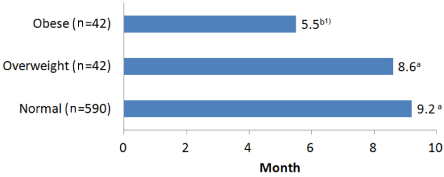
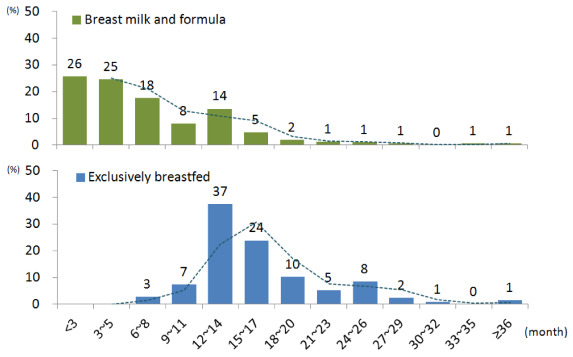
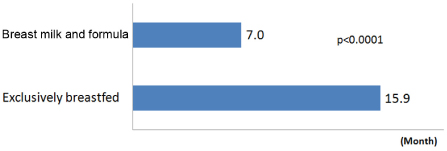
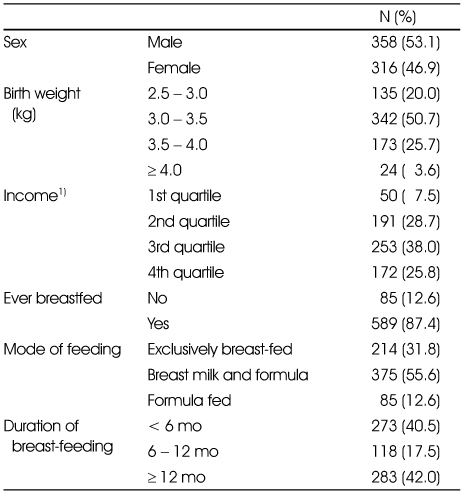

Figure & Data
REFERENCES
Citations

- Comparison of the growth and nutritional status of low birth weight and normal birth weight children
Hye-Young Kim
Journal of Nutrition and Health.2024; 57(6): 630. CrossRef - Breastfeeding and impact on childhood hospital admissions: a nationwide birth cohort in South Korea
Jeong-Seon Lee, Jae Il Shin, Sunyeup Kim, Yong-Sung Choi, Youn Ho Shin, Jimin Hwang, Jung U Shin, Ai Koyanagi, Louis Jacob, Lee Smith, Han Eol Jeong, Yunha Noh, In-Sun Oh, Sang Youl Rhee, Chanyang Min, Seong Ho Cho, Steve Turner, Guillaume Fond, Laurent B
Nature Communications.2023;[Epub] CrossRef - Association of Infant Feeding Characteristics With Dietary Patterns and Obesity in Korean Childhood
Kyoung-Nam Kim, Moon-Kyung Shin
Journal of Preventive Medicine and Public Health.2023; 56(4): 338. CrossRef - Feeding characteristics in infancy affect fruit and vegetable consumption and dietary variety in early childhood
Kyoung-Nam Kim, Moon-Kyung Shin
Nutrition Research and Practice.2023; 17(2): 307. CrossRef - Relations among Maternal Employment, Depressive Symptoms, Breastfeeding Duration, and Body Mass Index Trajectories in Early Childhood
Jihyoung Kim
Journal of The Korean Society of Maternal and Child Health.2020; 24(2): 75. CrossRef - Knowledge and health beliefs about gestational diabetes and healthy pregnancy's breastfeeding intention
Seungmi Park, Jung Lim Lee, Jang In Sun, Youngji Kim
Journal of Clinical Nursing.2018; 27(21-22): 4058. CrossRef - Exclusive breastfeeding and partial breastfeeding reduce the risk of overweight in childhood: A nationwide longitudinal study in Korea
Seon-Joo Park, Hae-Jeung Lee
Obesity Research & Clinical Practice.2018; 12(2): 222. CrossRef - Dietary status of young children in Korea based on the data of 2013 ~ 2015 Korea National Health and Nutrition Examination Survey
Eun-kyung Kim, Byengchun Song, Se-Young Ju
Journal of Nutrition and Health.2018; 51(4): 330. CrossRef - The Relationship Between Breastfeeding Duration and Preschooler Problem Behavior:
The Mediating Role of Cognitive Development
Sujeong Kang, Yea-Ji Hong, Naya Choi, Kangyi Lee
Korean Journal of Child Studies.2017; 38(6): 63. CrossRef - Factors Affecting Obesity and Overweight in Korean Preschool Children: Based on the Korea National Health and Nutrition Examination Survey 2013-2014
Inju Hwang, Kyung-Sook Bang
Child Health Nursing Research.2016; 22(4): 237. CrossRef - Dietary Habits and Nutrient Intakes according to Feeding Method during Infant Period in Elementary School Students
Myung-Hwa Kang, Mi-Kyeong Choi, Hyun-Jin Kim, Yun-Jung Bae
Journal of the Korean Society of Food Science and Nutrition.2015; 44(1): 57. CrossRef



Fig. 1
Fig. 2
Fig. 3
Characteristics of 2~3 year old toddlers with normal birth-weight in Korea National Health and Nutrition Examination Survey (KNHANES) 2008~2011
1) Based on the individual income calculated from monthly household income in KNHANES: Household income / √ number of household members
Birth weight comparison by mode of feeding among 2~3 year old toddlers with normal birth-weight in KNHANES 2008~2011
1) Mean ± SD
Odds ratio for independent risk factors associated with being overweight and/or obese in the final logistic regression model of 674 2~3 year old toddlers with normal birth-weight in KNHANES 2008~2011
1) Based on the individual income calculated from monthly household income in KNHANES: Household income/ √ number of household members
Prevalence and adjusted odds ratio for some risk factors associated with being overweight and/or obesity among 2~3 year old toddlers with normal birth-weight in KNHANES 2008~2011
1) Adjusted by controlling for birth weight only
1) Based on the individual income calculated from monthly household income in KNHANES: Household income / √ number of household members
1) Mean ± SD
1) Based on the individual income calculated from monthly household income in KNHANES: Household income/ √ number of household members
1) Adjusted by controlling for birth weight only

 KSCN
KSCN
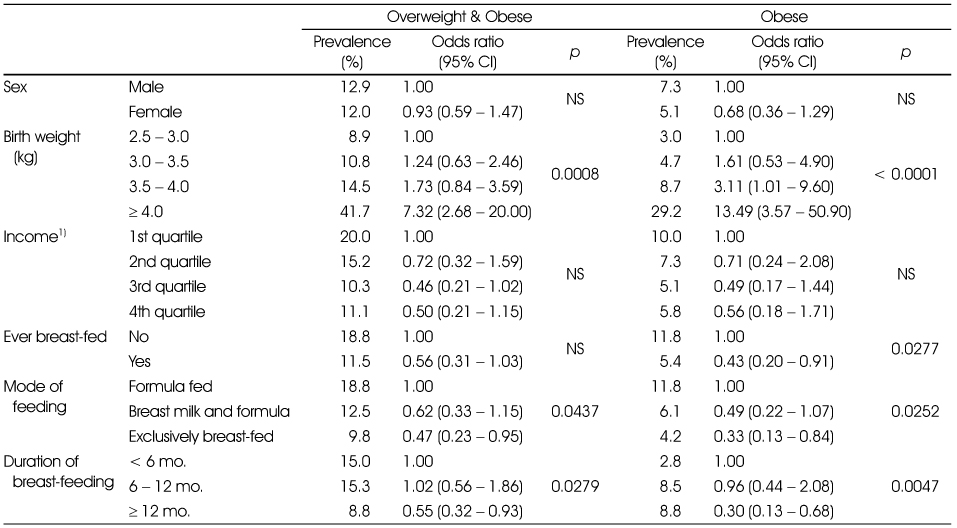

 Cite
Cite


